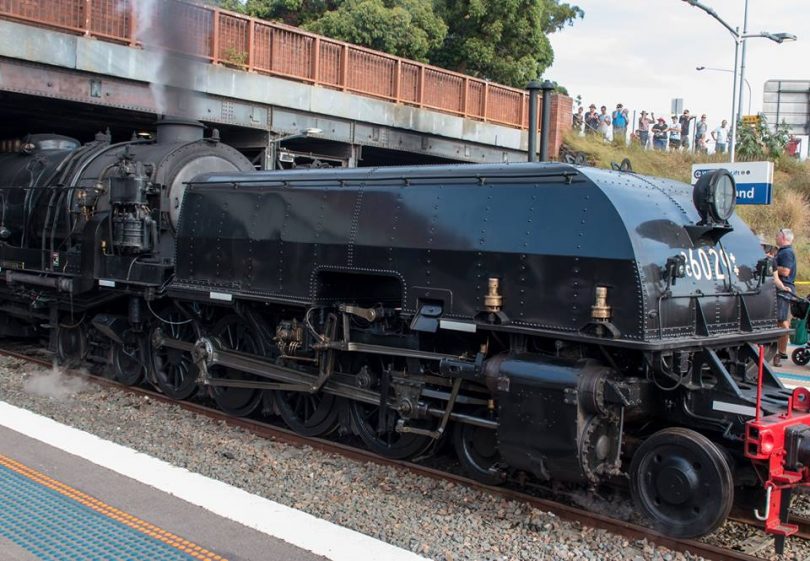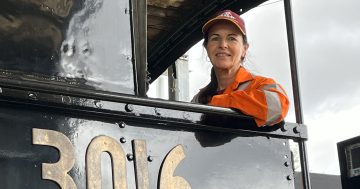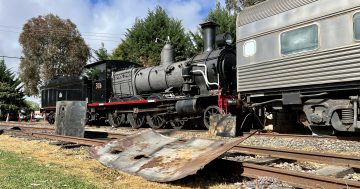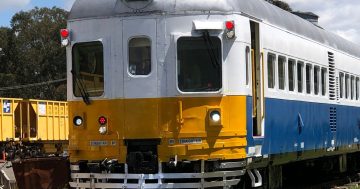
The Beyer-Garratt 6029 will be housed and maintained at the NSW Rail Museum in Thirlmere. Photo: Transport Heritage NSW Facebook.
The former pride of the Canberra Railway Museum’s heritage fleet, the Beyer-Garratt 6029 locomotive, is now in private hands and will remain at the NSW Rail Museum in Thirlmere.
The new owners of the locomotive, formerly known as the City of Canberra, have struck a one -year storage and use agreement, with options to extend, with Transport Heritage NSW (THNSW) and the NSW Rail Museum.
Phil Davis, a former steam train driver and Bathurst-based rail enthusiast, and former president of the Australian Railway Historical Society ACT Division David Sommerville, acquired 6029 on 10 November last year for an undisclosed amount as part of the ARHS liquidation.
A Facebook statement last November from Phil Davis said he and his colleague had purchased the locomotive to help ensure its long-term future and preservation as an operational locomotive.
“All involved have experience in this field. This is not a loco we expect will be operated often but carefully to help ensure the objective of longevity and preservation,” the statement said.
The locomotive had not been included in the August 2017 auction of ARHS assets that reportedly raised about $500,000 less costs, and it had been hoped that 6029, the largest operational steam locomotive in the Southern hemisphere, would be retained in what was left of the Canberra Rail Museum fleet, but it was put out to tender the next month.
It is believed a local consortium had been the preferred bidder but had fallen short of the amount needed to acquire 6029.
THNSW and the NSW Rail Museum announced the agreement on 28 February and the iconic locomotive was on display at Thirlmere’s Festival of Steam on 3-4 March.
The Save the Canberra Rail Museum Facebook site shared a post from the Hunter Valley Steamfest announcing that 6029 would be running there on 14-15 April, its second appearance at the festival after a 2016 visit.
“She makes it back to Steamfest, but no longer as the City of Canberra. The staff at Canberra Railway Museum are missing out on the crewing of that train. We all miss that week away. It was always the highlight of volunteering at the Museum. It is all now just memories, never to be repeated,” the post reads.
Mr Davis, who has worked with THNSW as a maintainer in the workshop and as a driver, told The RiotACT that many steam engines had come and gone over the years and “we wanted to do our bit to make sure this one is properly cared for and operated and be available for the general public and kids to see and ride behind”.
More caretakers than owners, he said they were keen for anyone who had worked with the locomotive to maintain their involvement.
“Thirlmere is not that far away from Canberra so it’s better than being in England or in the States, or worse, so certainly there are going to be opportunities to get it back down there again for tours,” he said.
“I think for the people who are sad that it has left Canberra, I hope they see that the loco is in service and in use, and it’s got a future.”
Mr Sommerville said he has had nothing but thanks from the Canberra heritage rail community for acquiring the engine.
He said he could not be sentimental about where 6029 needed to be, saying Canberra did not have the facilities to store and maintain the engine and those in Goulburn were too small for the Garratt.
There was no reason why 6029 would not again grace Canberra rails but there would have to be a reason for coming and on a cost-neutral basis.
“A long-time preservation of an object like this requires careful management and that means markets, marketing and that means understanding cost,” he said.
“If it was going to Canberra it’s got to have a reason to get there, and it’s not sentimentality. Sentiment can cause a loss and the loss would be the Garratt.”
Mr Sommerville said the ARHS liquidation could have been avoided if the members had agreed to sell assets to pay debts accumulated from the ill-fated freight business that he had inherited as president.
He said the venture, which was supposed to finance the restoration and heritage work, was not set up correctly and the business model was flawed.
He had asked the membership to support a sale of assets to meet their commitments but one dissenting voice stymied that plan.
“Because of that scaremongering we couldn’t sell the assets and had to put ourselves into liquidation,” he said.
“The reality is that if we’d been able to sell even half of that, we would have covered our debt, we could have retained control of the process and we would still have an operating arm and still had accreditation.”
Mr Sommerville said being at Thirlmere was the best outcome for the Garratt.
“It’s going to a place that’s stable and in an environment that’s got all the tools and equipment, resources, manpower and knowledge to look after it for all of us,” he said.
THNSW CEO Andrew Moritz said 6029 was transferred to the NSW Rail Museum along with other assets from the Canberra Railway Museum for storage and safe keeping when the ARHS ACT went into administration in late 2016.
“Once 6029 was sold, the new owners approached THNSW for a similar agreement to ensure the locomotive’s continued operation,” he said.
“Given the complexity involved with operating heritage trains within a modern-day rail network, THNSW has the necessary in-house skills expertise and facilities being one of only a few fully accredited heritage train operators in NSW.”

Photo: Hunter Valley Steamfest Facebook.
He said the agreement ensured the historic steam engine would be available for all to enjoy, with 6029 already booked to operate at four upcoming major events including the Hunter Valley Steamfest in April, Blue Mountains 150th in May, Sydney Transport Heritage Expo in June and a tour of the Riverina district in late August.
But it may be some time before Canberra will once again see the locomotive that carried its name.
“Given our forward program of events was confirmed prior to this agreement, we do not have any plans to visit Canberra this year,” Mr Moritz said.
“However, we are aware of the proud history this locomotive has with the Canberra community in recent years and we will be considering a return to the region one weekend in the future.”
Mr Moritz said that while the NSW Government funded THNSW, the Government would not directly support 6029 but the revenue earned from ticket sales would go towards costs associated with the locomotive’s operation, including current and future maintenance costs.
He said the engine had been assessed and found to have nothing major wrong with it, “however like any steam engine built in the 20th century still operating in the 21st century, unexpected maintenance can sometimes arise.”
Calls to the ARHS liquidator, Eddie Senatore from Deloittes, were not returned.
The Garratt was acquired by the National Museum of Australia in 1974 and placed in the care of the Australian Railway Historical Society’s Canberra Railway Museum, which restored it to working order.
It was named City of Canberra by Minister Shane Rattenbury on 23 February 2015.
The ARHS Canberra division went into liquidation last July after the failure of a freight business designed to finance its restoration and heritage work. It had racked up more than $700,000 in debts.
















